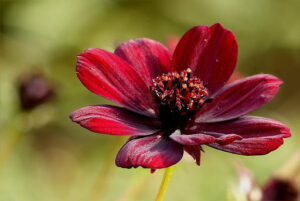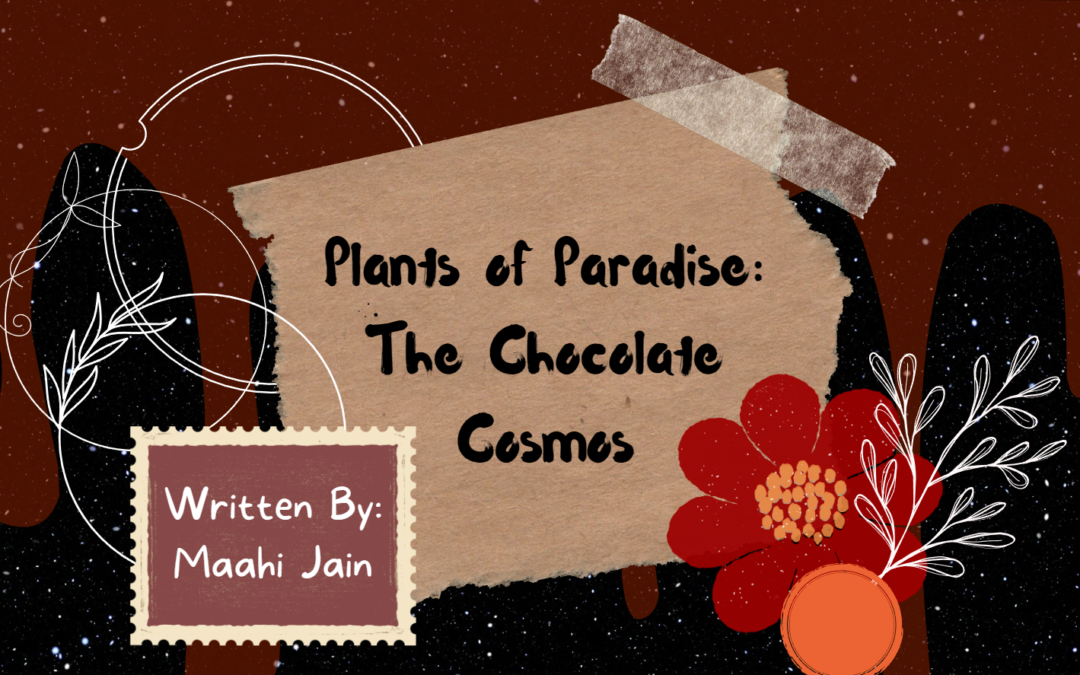Written by: Maahi Jain
Edited by: Kiritika Rana
Designed by: Tvisha Lakhani
Published by: Rayna Almas
“Cosmos Atrosanguineus” is not a term you hear on a daily basis–and it’s quite understandable. Widely known as the chocolate cosmos, it’s not a commonly studied species amongst those within the botanical field, given its long, complicated history. While some might think of this flower as nothing more than just a red daisy, others, particularly plant enthusiasts, will know just how distinctive this species is.
Architect of the renowned Thompson & Morgan Seed Company, William Thompson introduced the rare chocolate cosmos to the plant trade around the mid-1800s. It was discovered in Mexico, in mature oak and pine forests. Hence the reason this plant is more inclined towards warmer climates. The popularity of chocolate cosmos grew throughout the 20th century, due to its highly captivating, and chocolate-y sweet fragrance .
As a result of the two devastating world wars, the chocolate cosmos ceased to exist. However, there was one clone that remained; it was kept alive by horticulturalists at the Kew Gardens in England. The problem with this clone, though, was that it was self-sterile, which meant that it couldn’t fertilize its own flowers and would have needed pollen from other flowers. Neither seeds nor cultivars (variations within a plant species) could be produced with that clone. During the late 1900s, however, New Zealand propagated a self-fertile chocolate cosmos with a distinct DNA. Thereafter, the very first cultivar “Pinot Noir” was publicized by Russel Poulter, followed by others including choca mocha (the most available cultivar), dark secret, eclipse, and spellbound.
Chocolate cosmos is a part of the Asteraceae family, the family of daisies. Chocolate cosmos petals are rounded and their colours range from striking red to an almost black hue. They are perennials and reproduce via tuberous roots. These kinds of roots store nutrients which allows the plant to regrow during the warmer weather. A common example of a plant with tuberous roots is potato. Cosmos come in different colours, but the ones with the notable scent are of more a dark red or maroon.

The chocolate-y aroma of chocolate cosmos is a result of an organic compound called vanillin. This is the same compound found in cocoa. Their fragrance is most prominent during the warmer days or when it’s receiving direct sunlight (they love hot and dry conditions). Some cosmos flowers, such as pink, yellow, white, and orange ones, have a milder fragrance–or no fragrance at all. The unique colour of chocolate cosmos is determined by the varying amounts of anthocyanins and chalcones present. Anthocyanins are responsible for producing pink, red, purple and blue shades. Red appears in an environment where there is a high pH level (acidic), whereas blue is more pronounced where there is a low pH level (alkaline). Chalcones, on the other hand, produce a yellow colour.
Chocolate cosmos, despite the colour, require a lot of maintenance starting out, because they take quite some time germinating. However, once they do, they bloom pretty quickly and are easy to take care of. Although they do well in dry soils, a soil that retains some moisture (well drained) and with a fairly neutral pH is preferable. It is also recommended that when planting chocolate cosmos, a mix of potting soil and topsoil be used to ensure good growth. Furthermore, mulching them will ensure limited moisture loss. Using nutrient rich soil or fertilizer may cause the stem to weaken and will result in a toppled plant. You might also end up with more foliage than flowers. Fertilizer should only be used in circumstances where the flower isn’t doing too well. Chocolate cosmos don’t need to be watered regularly–too much water can cause the roots to rot. They benefit from deadheading–removing dead blooms so the plant produces more blossoms. When taken good care of, chocolate cosmos can grow to a height nearing 30 inches. If problems arise, it may be due to fungi present in the roots or stem such as, fusarium fungal infection, bacterial wilt infection, and powdery mildew.
Chocolate cosmos is a destination to multiple creatures who are a fan of its rich pollen. They commonly attract bees, butterflies and birds and repel deer. Despite it being unappetizing to deer, chocolate cosmos are highly valued plants for human medicinal purposes. They’re often used to reinforce bones, provide treatment to skin and help enhance circulation. In Mexican tradition, chocolate cosmos represents order and harmony (kosmos comes from the Greek language and means harmony). These flowers can best be paired with ornamental grasses, marigolds, and dahlias or amongst vegetables such as cabbage, kale, and sweet peas.
Chocolate cosmos are an amazing addition to butterfly gardens, childrens’ gardens, and meadows. They’re very easy to take care of considering they need very little sustenance so if you’re having trouble deciding which plant to grow in your garden, these chocolate-smelling flowers are the way to go!
Works Cited
Admin. (2023, January 14). Cosmos Flowers – Common Problems and Solutions – The Flower Expert. The Flower Expert. https://www.theflowerexpert.com/content/aboutflowers/tropicalflowers/cosmos-pink
Affeld, M. (2012, June 17). Chocolate Cosmos Growing Tips. Week&. https://www.weekand.com/home-garden/article/chocolate-cosmos-growing-tips-18003924.php
Aloi, P. (2021, September 14). How to Grow Chocolate Cosmos. The Spruce. https://www.thespruce.com/chocolate-cosmos-profile-5181704
Amamiya, K., & Iwashina, T. (2015, November 15). Qualitative and Quantitative Analysis of Flower Pigments in Chocolate Cosmos, Cosmos Atrosanguineus, and its Hybrids. Natural Product Communications. https://journals.sagepub.com/doi/pdf/10.1177/1934578X1601100122
closeup, photography, red, cosmos flower, chocolate flower, autumn, park, nature, plant, petal [Photograph] Pxfuel. (n.d.). https://www.pxfuel.com/en/free-photo-joexq
DDW. (2021). Why Do Anthocyanins Change Color. DDW. https://learn.ddwcolor.com/why-do-anthocyanins-change-color/
Dowdall, P. (2022, August 15). Peter Dowdall: Here’s how the chocolate cosmos got its name. Irish Examiner. https://www.irishexaminer.com/property/homeandgardens/arid-40940642.html#:~:text=Originally%20introduced%20from%20Mexico%20in,became%20widely%20available%20from%201885
Gaumond, A. (2021, September 2). Ultimate Guide to Cosmos Flower Meaning. Petal Republic. https://www.petalrepublic.com/cosmos-flower-meaning/#:~:text=and%20Cosmos%20astrosanguineus.-,Etymological%20Meaning,and%20harmony%20of%20the%20universe
Hicks-Hamblin, K. (2022, March 17). How to Grow and Care for Cosmos Flowers. Gardener’s Path. https://gardenerspath.com/plants/flowers/grow-cosmos/
Hodgson, L. (2017, April 3). Chocolate Cosmos: New and Improved. Laidback Gardener. https://laidbackgardener.blog/2017/04/03/chocolate-cosmos-new-and-improved/
Holmes, K. (2022, July 25). Gardening 101: Chocolate Cosmos. Gardenista. https://www.gardenista.com/posts/gardening-101-chocolate-cosmos/

